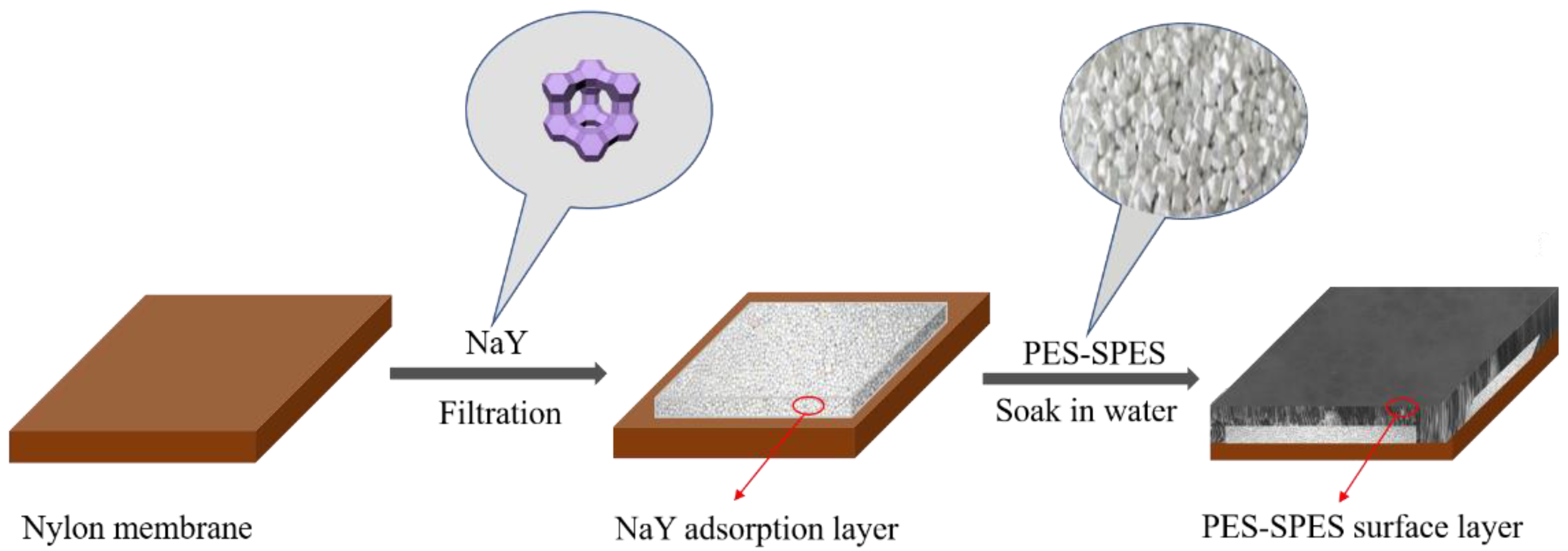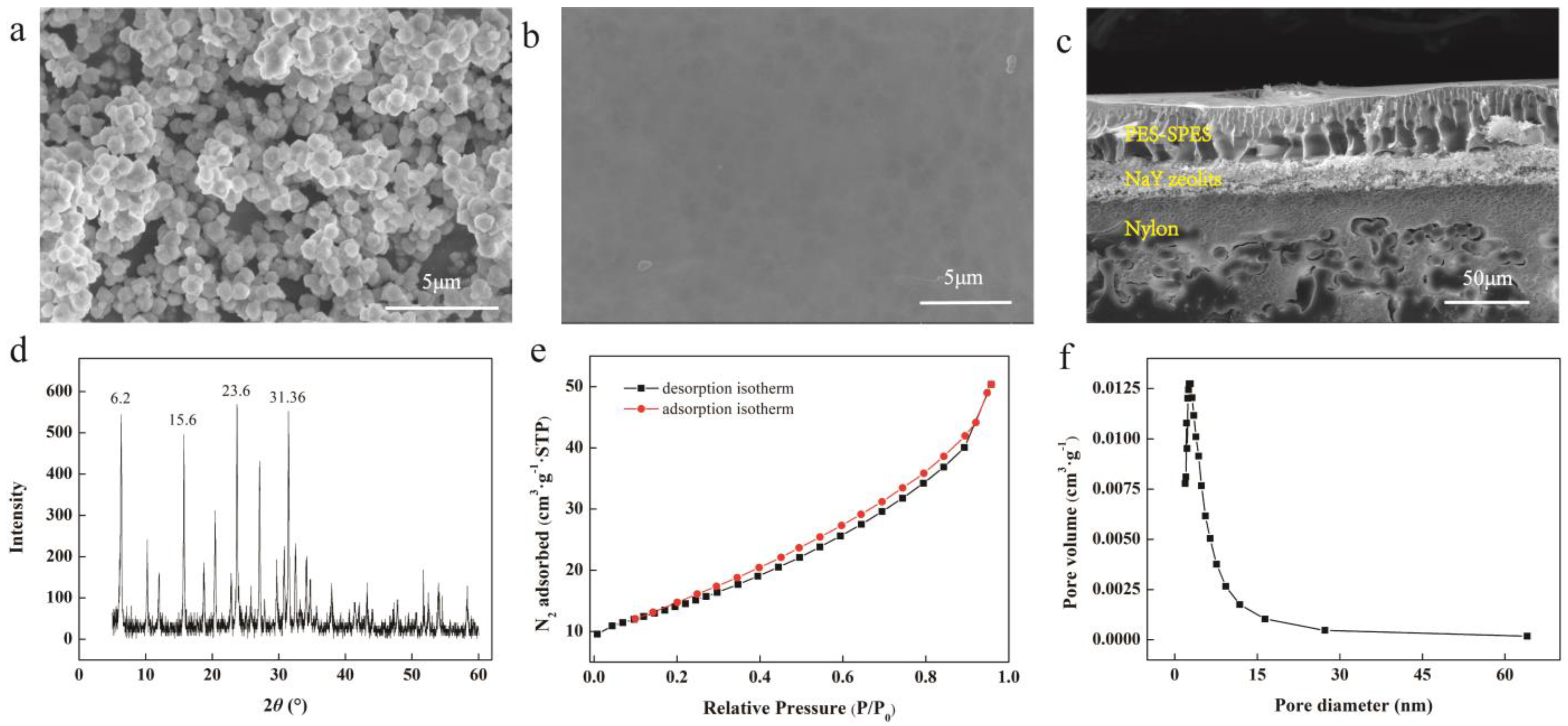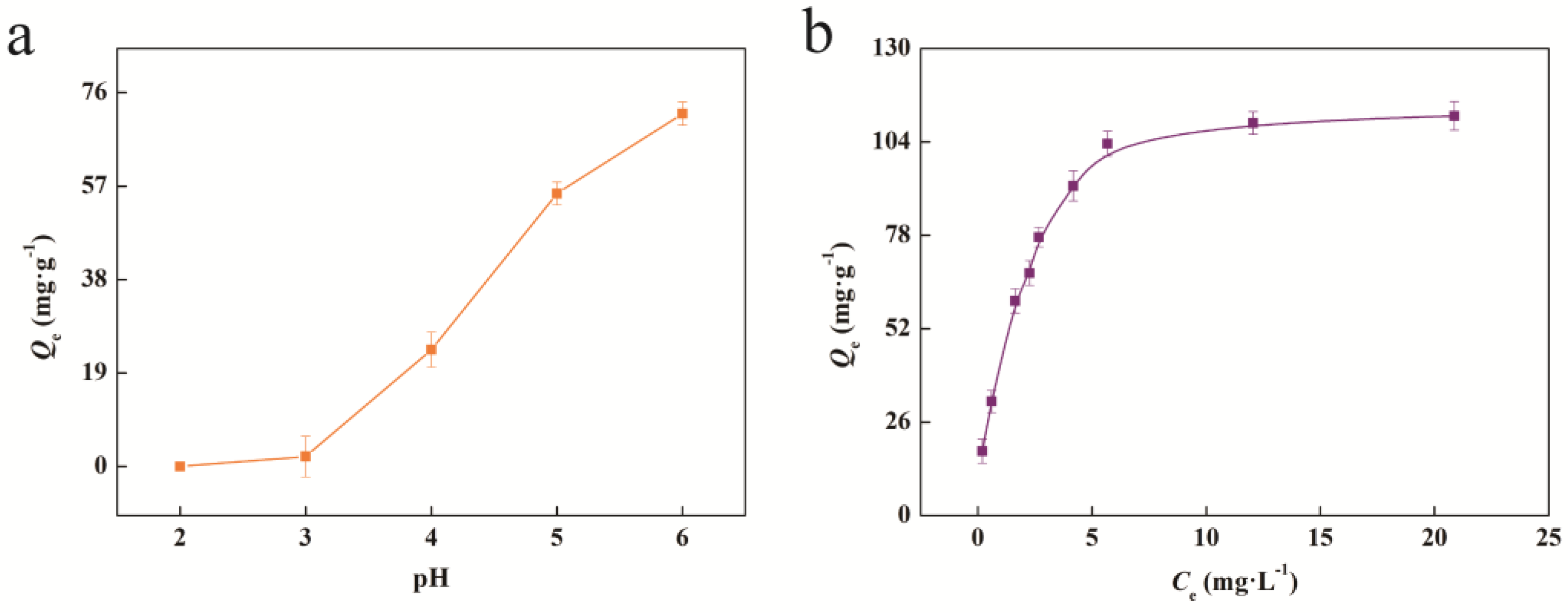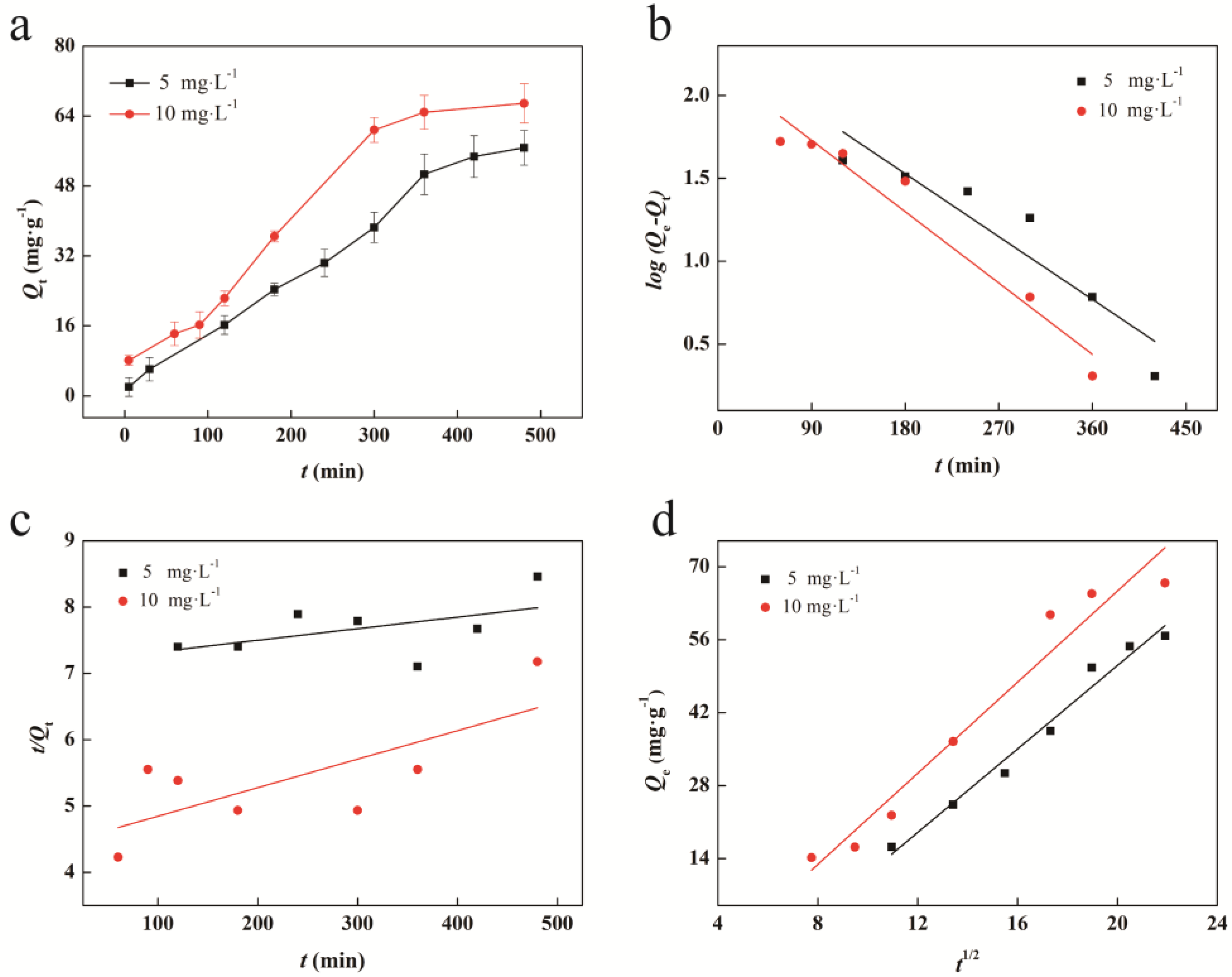Facile Separation of Cu2+ from Water by Novel Sandwich NaY Zeolite Adsorptive Membrane
Abstract
1. Introduction
2. Experimental Part
2.1. Materials
2.2. Preparation of NaY Zeolite
2.3. Preparation of PES-SPES/NaY Zeolite/Nylon Sandwich Adsorptive Membrane
2.4. Static Adsorption
2.5. Dynamic Adsorption and Desorption
2.6. Characterization
3. Results and Discussion
3.1. Characterization of Sandwich Membrane
3.2. Adsorption Isotherm
3.3. Adsorption Kinetics
3.4. Dynamic Adsorption and Desorption
4. Conclusions
Author Contributions
Funding
Data Availability Statement
Conflicts of Interest
References
- Rahman, N.; Azmi, S.N.H.; Wu, H.-F. The importance of impurity analysis in pharmaceutical products: An integrated approach. Accredit. Qual. Assur. 2006, 11, 69–74. [Google Scholar] [CrossRef]
- Tabersky, D.; Woelfle, M.; Ruess, J.-A.; Brem, S.; Brombacher, S. Recent regulatory trends in pharmaceutical manufacturing and their impact on the industry. Chimia 2018, 72, 146–150. [Google Scholar] [CrossRef] [PubMed]
- Wollein, U.; Bauer, B.; Habernegg, R.; Schramek, N. Potential metal impurities in active pharmaceutical substances and finished medicinal products—A market surveillance study. Eur. J. Pharm. Sci. 2015, 77, 100–105. [Google Scholar] [CrossRef] [PubMed]
- Rao, R.N.; Talluri, M.K. An overview of recent applications of inductively coupled plasma-mass spectrometry (ICP-MS) in determination of inorganic impurities in drugs and pharmaceuticals. J. Pharm. Biomed. Anal. 2007, 43, 1–13. [Google Scholar] [CrossRef]
- Abdullaev, M.G. Kinetics of one-step mepivacaine synthesis on polymers containing Pd-nanoparticles. Pharm. Chem. J. 2019, 52, 865–867. [Google Scholar] [CrossRef]
- Tian, S.X.; Tang, B.; Zhang, M.Z.; Gao, Q.J.; Chen, B. An improved synthesis of rivaroxaban. Org. Prep. Proced. Intern. 2017, 49, 169–177. [Google Scholar] [CrossRef]
- Min, Y.; Shi, F.G. The Preparation and characterization of zinc chloride-loaded bentonite solid acid catalyst. J. Yunnan Natl. Univ. 2007, 2, 168–171. [Google Scholar]
- Bamoharram, F.F.; Heravi, M.M.; Roshani, M.; Gharib, A.; Jahangir, M. Catalytic method for synthesis of aspirin by a green, efficient and recyclable solid acid catalyst (Preyssler’s Anion) at Room Temperature. J. Chin. Chem. Soc. 2013, 54, 1017–1020. [Google Scholar] [CrossRef]
- Sharma, A.; Jain, S.K. Elemental impurities in drug product. Int. J. Pharm. Sci. Res. 2017, 2, 31–38. [Google Scholar]
- Pohl, P.; Bielawska-Pohl, A.; Dzimitrowicz, A.; Jamroz, P.; Welna, M. Impact and practicability of recently introduced requirements on elemental impurities. Trac Trends Anal. Chem. 2018, 101, 43–55. [Google Scholar] [CrossRef]
- Cheraghi, M.; Lorestani, B.; Yousefi, N. Effect of waste water on heavy metal accumulation in hamedan province vegetables. Int. J. Bot. 2009, 5, 190–193. [Google Scholar] [CrossRef]
- Reglero, M.; Taggart, M.; Lidia, M.; Rafael, M. Heavy metal exposure in large game from a lead mining area: Effects on oxidative stress and fatty acid composition in liver. Environ. Pollut. 2009, 157, 1388–1395. [Google Scholar] [CrossRef] [PubMed]
- Kampa, M.; Castanas, E. Human health effects of air pollution. Environ. Pollut. 2008, 151, 362–367. [Google Scholar] [CrossRef] [PubMed]
- Gybina, A.A.; Prohaska, J.R. Copper deficiency results in AMP-activated protein kinase activation and acetylCoA carboxylase phosphorylation in rat cerebellum. Brain Res. 2008, 1204, 69–76. [Google Scholar] [CrossRef]
- Araya, M.; McGoldrick, M.C.; Klevay, L.M.; Strain, J.; Robson, P.; Nielsen, F.; Olivares, M.; Pizarro, F.; Johnson, L.; Poirier, K.A. Determination of an acute no-observed-adverse-effect level (NOAEL) for copper in water. Regul. Toxicol. Pharmacol. 2001, 34, 137–145. [Google Scholar] [CrossRef] [PubMed]
- Chuttani, H.; Gupta, P.; Gulati, S.; Gupta, D. Acute copper sulfate poisoning. Am. J. Med. 1965, 39, 849–854. [Google Scholar] [CrossRef] [PubMed]
- Nuttall, J.R.; Oteiza, P.I. Zinc and the aging brain. Genes Nutr. 2014, 9, 379. [Google Scholar] [CrossRef] [PubMed]
- Faller, P. Copper in Alzheimer disease: Too much, too little, or misplaced? Free. Radic. Biol. Med. 2012, 52, 747–748. [Google Scholar] [CrossRef]
- Afroze, S.; Sen, T.K. A Review on heavy metal ions and dye adsorption from water by agricultural solid waste adsorbents. Water Air Soil Pollut. 2018, 229, 225. [Google Scholar] [CrossRef]
- Cocâr, D.; Deac, A. Carcinogenic risk evaluation for human health risk assessment from soils contaminated with heavy metals. Int. J. Environ. Sci. Technol. 2016, 13, 2025–2036. [Google Scholar] [CrossRef]
- Stewart, M.P.; Langer, R.; Jensen, K.F. Intracellular delivery by membrane disruption: Mechanisms, strategies, and concepts. Chem. Rev. 2018, 118, 7409–7531. [Google Scholar] [CrossRef] [PubMed]
- Yang, J.; Hou, B.; Wang, J.; Tian, B.; Bi, J.; Wang, N.; Li, X.; Huang, X. Nanomaterials for the removal of heavy metals from wastewater. Nanomaterials 2019, 9, 424. [Google Scholar] [CrossRef]
- Yao, G.; Li, S.; Xu, J.; Liu, H. Dual-Responsive Graphene Oxide/Poly(NIPAM-co-AA) Hydrogel as an Adsorbent for Rhodamine B and Imidacloprid. J. Chem. Eng. Data 2019, 64, 4054–4065. [Google Scholar] [CrossRef]
- Demirbas, A.; Pehlivan, E.; Fethiye, G.; Turkan, A.; Gulsin, A. Adsorption of Cu(II), Zn(II), Ni(II), Pb(II), and Cd(II) from aqueous solution on Amberlite IR-120 synthetic resin. J. Colloid Interface Sci. 2005, 282, 20–25. [Google Scholar] [CrossRef] [PubMed]
- Peri, J.; Trgo, M.; Medvidovi, N.V. Removal of zinc, copper and lead by natural zeolite-A comparison of adsorption iso-therms. Water Res. 2004, 38, 1893–1899. [Google Scholar] [CrossRef] [PubMed]
- Ghaedi, M.; Nasab, A.G.; Khodadoust, S.; Rajabi, M.; Azizian, S. Application of activated carbon as adsorbents for efficient removal of methylene blue: Kinetics and equilibrium study. J. Ind. Eng. Chem. 2014, 20, 2317–2324. [Google Scholar] [CrossRef]
- Cheng, T.H.; Sankaran, R.; Show, P.L.; Ooi, C.W.; Liu, B.L. Removal of protein wastes by cylinder-shaped NaY zeolite ad-sorbents decorated with heavy metal wastes. Int. J. Biol. Macromol. 2021, 185, 761–772. [Google Scholar] [CrossRef]
- Coronas, J. Present and future synthesis challenges for zeolites. Chem. Eng. J. 2010, 156, 236–242. [Google Scholar] [CrossRef]
- Olegario, E.; Pelicano, C.M.; Felizco, J.C.; Mendoza, H. Thermal stability and heavy metal (As5+, Cu2+, Ni2+, Pb2+ and Zn2+) ions uptake of the natural zeolites from the Philippines. Mater. Res. Express 2019, 6, 085204. [Google Scholar] [CrossRef]
- Fan, X.; Liu, H.; Anang, E.; Ren, D. Effects of electronegativity and hydration energy on the selective adsorption of heavy metal ions by synthetic NaX zeolite. Materials 2021, 14, 4066. [Google Scholar] [CrossRef]
- Zhao, Y. Review of the natural, modified, and synthetic zeolites for heavy metals removal from wastewater. Environ. Eng. Sci. 2016, 33, 443–454. [Google Scholar]
- Abdullah, N.; Yusof, N.; Lau, W.J.; Jaafar, J.; Ismail, A.F. Recent trends of heavy metal removal from water/wastewater by membrane tech-nologies. J. Ind. Eng. Chem. 2019, 76, 17–38. [Google Scholar] [CrossRef]
- Yurekli, Y. Removal of heavy metals in wastewater by using zeolite nano-particles impregnated polysulfone membranes. J. Hazard. Mater. 2016, 309, 53–64. [Google Scholar] [CrossRef] [PubMed]
- Hao, S.; Jia, Z.; Wen, J.; Li, S.; Peng, W.; Huang, R.; Xu, X. Progress in adsorptive membranes for separation—A review. Sep. Purif. Technol. 2020, 255, 117772. [Google Scholar] [CrossRef]
- Isa, M.A.; Chew, T.L.; Yeong, Y.F. Zeolite NaY synthesis by using sodium silicate and colloidal silica as silica source. IOP Conf. Ser. Mater. Sci. Eng. 2018, 458, 012001. [Google Scholar] [CrossRef]
- Lu, D.; Zou, H.; Guan, R.; Dai, H.; Lu, L. Sulfonation of polyethersulfone by chlorosulfonic acid. Polym. Bull. 2005, 54, 21–28. [Google Scholar] [CrossRef]
- Kim, I.C.; Choi, J.G.; Tak, T.M. Sulfonated polyethersulfone by heterogeneous method and its membrane performances. J. Appl. Polym. Sci. 1999, 74, 2046–2055. [Google Scholar] [CrossRef]
- Mthombo, T.S.; Mishra, A.K.; Mishra, S.B.; Mamba, B.B. The adsorption behavior of Cu(II), Pb(II), and Co(II) of ethylene vinyl acetate-clinoptilolite nanocomposites. J. Appl. Polym. Sci. 2011, 121, 3414–3424. [Google Scholar] [CrossRef]
- Fei, F.; Cseri, L.; Szekely, G.; Blanford, C.F. Robust covalently cross-linked polybenzimidazole/graphene oxide membranes for high-flux organic solvent nanofiltration. ACS Appl. Mater. Interfaces 2018, 10, 16140–16147. [Google Scholar] [CrossRef]
- Standardization Administration of the People’s Republic of China. HJ 486-2009; Water Quality Determination of Copper 2, 9-Dimethy-1,10-Phenanthroline Spectrophotometric Method. Standards Press of China: Beijing, China, 2009.
- Liu, Z.; Shi, C.; Wu, D.; He, S.; Ren, B. A simple method of preparation of high silica zeolite y and its performance in the catalytic cracking of cumene. J. Nanotechnol. 2016, 2016, 1486107. [Google Scholar] [CrossRef]
- Zeng, Y.; Phadungbut, P.; Do, D.D.; Nicholson, D. Anatomy of adsorption in open-end and closed-end slit mesopores: Adsorption, desorption, and equilibrium branches of hysteresis loop. J. Phys. Chem. C 2014, 118, 25496–25504. [Google Scholar] [CrossRef]
- Beck, J.S.; Vartuli, J.C.; Roth, W.J.; Leonowicz, M.E.; Kresge, C.T.; Schmitt, K.D.; Chu, C.T.W.; Olson, D.H.; Sheppard, E.W.; McCullen, S.B.; et al. A new family of mesoporous molecular sieves prepared with liquid crystal templates. J. Am. Chem. Soc. 1992, 114, 10834–10843. [Google Scholar] [CrossRef]
- Kuleyin, A. Removal of phenol and 4-chlorophenol by surfactant-modified natural zeolite. J. Hazard. Mater. 2007, 144, 307–315. [Google Scholar] [CrossRef] [PubMed]
- Chaudhry, S.A.; Zaidi, Z.; Siddiqui, S.I. Isotherm, kinetic and thermodynamics of arsenic adsorption onto Iron-Zirconium Binary Oxide-Coated Sand (IZBOCS): Modelling and process optimization. J. Mol. Liq. 2017, 229, 230–240. [Google Scholar] [CrossRef]
- Li, X.; Xu, Q.; Han, G.; Zhu, W.; Chen, Z.; He, X.; Tian, X. Equilibrium and kinetic studies of copper(II) removal by three species of dead fungal biomasses. J. Hazard. Mater. 2009, 165, 469–474. [Google Scholar] [CrossRef]
- Başar, C.A. Applicability of the various adsorption models of three dyes adsorption onto activated carbon prepared waste apricot. J. Hazard. Mater. 2006, 135, 232–241. [Google Scholar] [CrossRef]
- Gok, O.; Ozcan, A.; Erdem, B. Prediction of the kinetics, equilibrium and thermodynamic parameters of adsorption of copper (II) ions onto 8-hydroxy quinoline immobilized bentonite. Colloids Surf. A Physicochem. Eng. Asp. 2008, 317, 174. [Google Scholar] [CrossRef]
- Shen, J.; Li, K.; Muhammad, Y.; Zhang, N.; Guo, X.; Subhan, S.; Lan, C.; Liu, K.; Huang, F. Removal of Cu(II) ions from simulated wastewater using bagasse pith grafted polyacrylamide copolymer. Chem. Eng. Res. Des. 2020, 164, 361–372. [Google Scholar] [CrossRef]
- Pooladi, A.; Bazargan-Lari, R. Simultaneous removal of copper and zinc ions by Chitosan/Hydroxyapatite/nano-Magnetite composite. J. Mater. Res. Technol. 2020, 9, 14841–14852. [Google Scholar] [CrossRef]
- Kulkarni, P.; Watwe, V.; Pathak, G.; Sayyad, S.; Kulkarni, S. Evaluation of thermodynamic parameters via reaction stoichiometry and the corrected Langmuir parameter for sorption of Cu(II) on chitosan and chitosan blended PVA films. J. Mol. Liq. 2020, 317, 113962. [Google Scholar] [CrossRef]
- Shi, W.; Zhang, F.; Zhang, G. Mathematical analysis of affinity membrane chromatography. J. Chromatogr. A 2005, 1081, 156–162. [Google Scholar] [CrossRef] [PubMed]
- Pérez, P.; Aizman, A.; Contreras, R. Comparison between Experimental and Theoretical Scales of Electrophilicity Based on Reactivity Indexes. J. Phys. Chem. A 2002, 106, 3964–3966. [Google Scholar] [CrossRef]
- Juang, R.-S.; Wu, F.-C.; Tseng, R.-L. Characterization and use of activated carbons prepared from bagasses for liquid-phase adsorption. Colloids Surfaces A Physicochem. Eng. Asp. 2002, 201, 191–199. [Google Scholar] [CrossRef]
- Liu, P.; Wang, X.L.; Tian, L.; He, B.; Lv, X.; Li, X.; Wang, C.; Song, L. Adsorption of silver ion from the aqueous solution using apolyvinylidene fluoride functional membrane bearing thiourea groups. J. Water Process Eng. 2020, 34, 101184. [Google Scholar] [CrossRef]






| Isotherm Model | Parameters | − |
|---|---|---|
| Freundlich | 1/a | 0.5792 |
| kF (mg g−1) (L mg−1)1/n | 2.976 | |
| R2 | 0.899 | |
| Langmuir | Qm (mg g−1) | 111.3 |
| b (L mg−1) | 0.922 | |
| R2 | 0.974 | |
| D-R | k | 0.00201 |
| E (kJ mol−1) | 15.77 | |
| R2 | 0.869 |
| Adsorbents | Concentrations (mg L−1) | Adsorption Time (min) | Saturated Adsorption Capacity (mg g−1) | Reference |
|---|---|---|---|---|
| Natural zeolites from the Philippines | 136 | 360 | 14.65 | [29] |
| bagasse pith grafted copolymer (BPGC) | 6 | 700 | 105 | [49] |
| Chitosan/hydroxyapatite/nano-magnetite (Fe3O4) composite | 1–5 | 100 | 3.65 | [50] |
| Chitosan blended with polyvinyl alcohol (PVA) membrane | 20–100 | 720 | 35.71 | [51] |
| PES-SPES/NaY zeolite/nylon sandwich membrane | 1–25 | 480 | 111.3 | This work |
| Kinetic Models | Parameters | 5 mg L−1 | 10 mg L−1 |
|---|---|---|---|
| The pseudo first order | Slope | −0.0042 | −0.0048 |
| Intercept | 2.286 | 2.160 | |
| k1 (min−1) | 0.0097 | 0.011 | |
| R2 | 0.850 | 0.941 | |
| The pseudo second order | Slope | 0.0017 | 0.0043 |
| Intercept | 7.151 | 4.416 | |
| k2 (g mg−1 min−1) | 4.04 × 10−7 | 4.20 × 10−6 | |
| R2 | 0.120 | 0.454 | |
| Intra-particle diffusion model | Slope (ki (mg g−1 min−1/2)) | 4.005 | 4.371 |
| Intercept (C (mg g−1)) | −29.028 | −22.071 | |
| R2 | 0.974 | 0.949 |
Disclaimer/Publisher’s Note: The statements, opinions and data contained in all publications are solely those of the individual author(s) and contributor(s) and not of MDPI and/or the editor(s). MDPI and/or the editor(s) disclaim responsibility for any injury to people or property resulting from any ideas, methods, instructions or products referred to in the content. |
© 2023 by the authors. Licensee MDPI, Basel, Switzerland. This article is an open access article distributed under the terms and conditions of the Creative Commons Attribution (CC BY) license (https://creativecommons.org/licenses/by/4.0/).
Share and Cite
Guo, Y.; Zhang, X.; Xie, Y.; Hu, Y.; Jia, Z.; Ma, Y.; Wang, X. Facile Separation of Cu2+ from Water by Novel Sandwich NaY Zeolite Adsorptive Membrane. Separations 2023, 10, 171. https://doi.org/10.3390/separations10030171
Guo Y, Zhang X, Xie Y, Hu Y, Jia Z, Ma Y, Wang X. Facile Separation of Cu2+ from Water by Novel Sandwich NaY Zeolite Adsorptive Membrane. Separations. 2023; 10(3):171. https://doi.org/10.3390/separations10030171
Chicago/Turabian StyleGuo, Yuexin, Xu Zhang, Yuesheng Xie, Yacong Hu, Zhiqian Jia, Yafei Ma, and Xin Wang. 2023. "Facile Separation of Cu2+ from Water by Novel Sandwich NaY Zeolite Adsorptive Membrane" Separations 10, no. 3: 171. https://doi.org/10.3390/separations10030171
APA StyleGuo, Y., Zhang, X., Xie, Y., Hu, Y., Jia, Z., Ma, Y., & Wang, X. (2023). Facile Separation of Cu2+ from Water by Novel Sandwich NaY Zeolite Adsorptive Membrane. Separations, 10(3), 171. https://doi.org/10.3390/separations10030171







